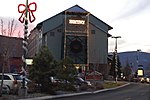Peavine Peak
Mountains of NevadaMountains of Washoe County, Nevada

Peavine Peak, the highest point on Peavine mountain, is located in Washoe County Nevada, at the northwest corner of the Truckee Meadows and about 3.5 miles (5.6 km) due east of the California state. It forms one of the most dominant geographical features in the Reno/Sparks area. Early prospectors to the mountain discovered wild pea vines growing in the vicinity of Peavine Springs on the northeast flank of the mountain, near Poeville, hence the name.
Excerpt from the Wikipedia article Peavine Peak (License: CC BY-SA 3.0, Authors, Images).Peavine Peak
Peavine Road,
Geographical coordinates (GPS) Address Nearby Places Show on map
Geographical coordinates (GPS)
| Latitude | Longitude |
|---|---|
| N 39.586920217 ° | E -119.932138508 ° |
Address
Peavine Road
Peavine Road
89523
Nevada, United States
Open on Google Maps




